Sun Star, also known as Ornithogalum dubium, is a popular ornamental plant that belongs to the Asparagaceae family. It is native to South Africa and is known for its stunning bright orange, star-shaped flowers that bloom in clusters atop long stalks.
The plant is easy to grow and maintain, making it a favorite among gardeners and indoor plant enthusiasts. Sun Star plants are typically grown for their attractive foliage and vibrant blooms, which can last for several weeks.
They are perfect for adding a splash of color to any garden or indoor space and can be grown as perennials or annuals, depending on the climate. In this guide, we will provide you with all the information you need to know about caring for Sun Star plants.

What is a Sun Star Plant?
The orange star plant (Ornithogalum dubium) is a perennial flowering plant belonging to the Asparagaceae family. Also known as the star of Bethlehem and sun star plant, the orange star plant gets its name from its star-shaped, bright orange flowers.
Orange star plants are native to South Africa and as outdoor plants, they do best in warm climates. They typically only grow up to one or two feet tall. It’s a bulbous plant, meaning that it grows from an underground bulb.
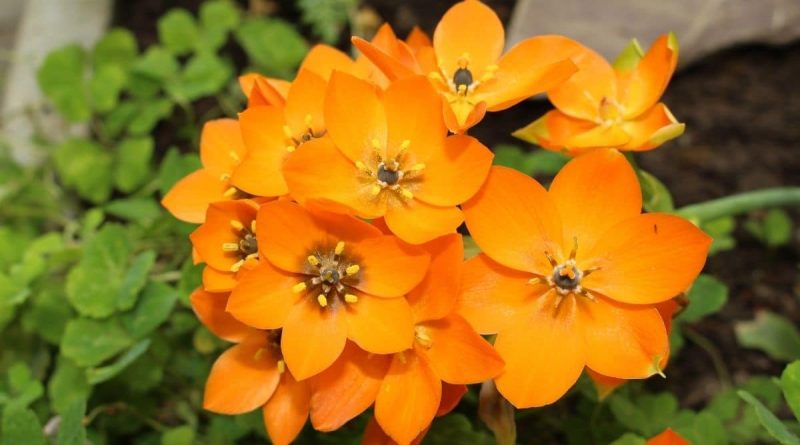
One of the most distinctive features of the Sun Star plant is its bright orange, star-shaped flowers. The flowers bloom in clusters atop long, thin stems and can last for several weeks.
Sun Star plants are hardy and adaptable, making them easy to grow and maintain.
They can be grown in a variety of soil types and light conditions, although they prefer well-draining soil and bright, indirect light. Sun Star plants are often grown as perennials in warmer climates, while they are grown as annuals in cooler climates.
The bulbs can be overwintered by removing them from the ground in colder climates and reintroduced to the garden in late spring.
Sun Star Plant Basics:
| Common Name: | Star of Bethlehem, Yellow Chincherinchee, Snake flower, Sun flower, Sunshine Lily |
| Botanical Name: | Ornithogalum dubium |
| Plant Type: | Flowering houseplant |
| Size: | 8 -15 inches |
| Light: | Bright indirect light, no more than 2 hours of direct light |
| Soil: | A mixture of peat moss, perlite, and sand or vermiculite can provide a suitable growing medium |
| Water: | Regular weekly watering |
| Vulnerabilities: | Overwatering, spider mites, fungal disease, root rot |
| USDA Growing Zones: | 7-10 as outdoor plants |
How to Care for Sun Star Plant
To keep your Sun Star plant healthy and thriving, it is important to provide it with the proper care. Here are some tips on how to care for your Sun Star plant, including information on light, water, soil, and fertilizer needs.
Type of Soil
Sun Star plants prefer well-draining soil that is rich in nutrients. A mixture of peat moss, perlite, and sand is a good choice. This type of soil will ensure that the plant's roots have access to adequate oxygen and nutrients and have adequate drainage to prevent waterlogging the roots.
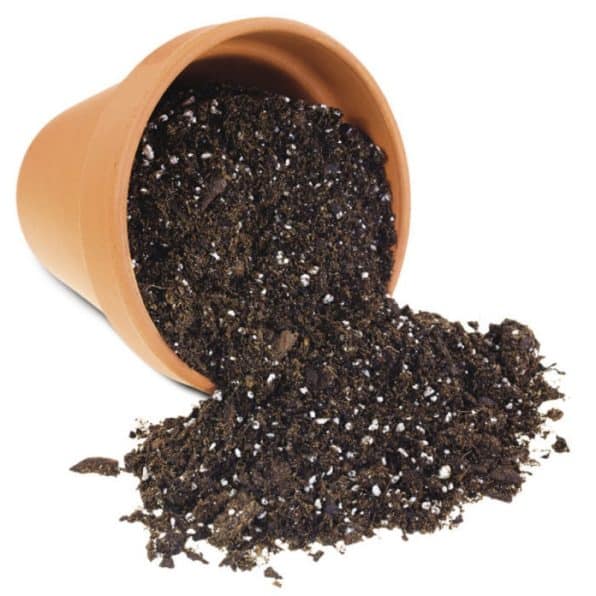
It is recommended to avoid heavy, clay soils or soils that retain too much moisture, as this can lead to root rot and other issues.
How Often to Water Sun Star Plant
Sun Star plants require regular watering, but it is important not to overwater them. The frequency of watering will depend on factors such as the plant's size, the type of soil it's planted in, and the environmental conditions.
As a general rule, Sun Star plants should be watered when the top inch of soil feels dry to the touch. This usually translates to watering every 7-10 days, but it's always best to check the soil moisture level before watering.
Amount of Light for Sun Star
The Sun Star likes bright light and can tolerate direct sun. During the summer months, it's best to have some shade for the hottest parts of the day.Sun Star plants prefer bright, indirect light indoors.
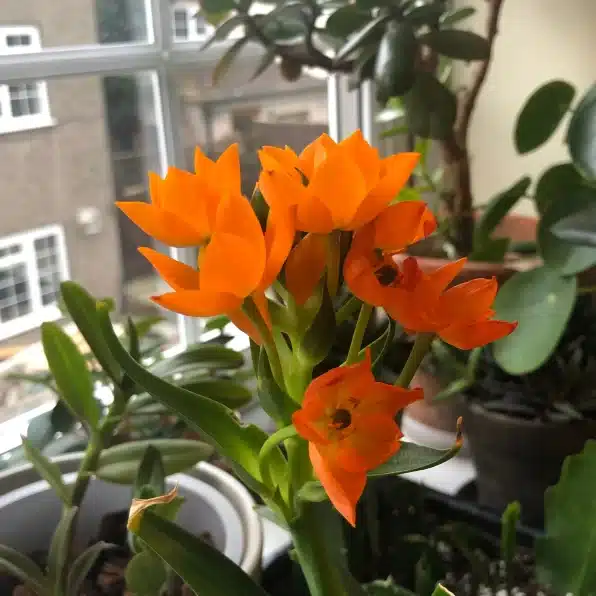
Your plant will require at least 4-6 hours of sunlight per day, but it is important to avoid direct sunlight shining through a window during the heat of the day, which can scorch the leaves.
Temperature & Humidity Levels
Sun Star plants prefer warm temperatures and moderate humidity levels. They thrive in temperatures between 60-75°F (15-24°C) during the day and around 50-55°F (10-13°C) at night.
While they can tolerate lower temperatures for short periods, exposure to temperatures below 50°F (10°C) can cause your plant to think it's time to sleep for the winter.
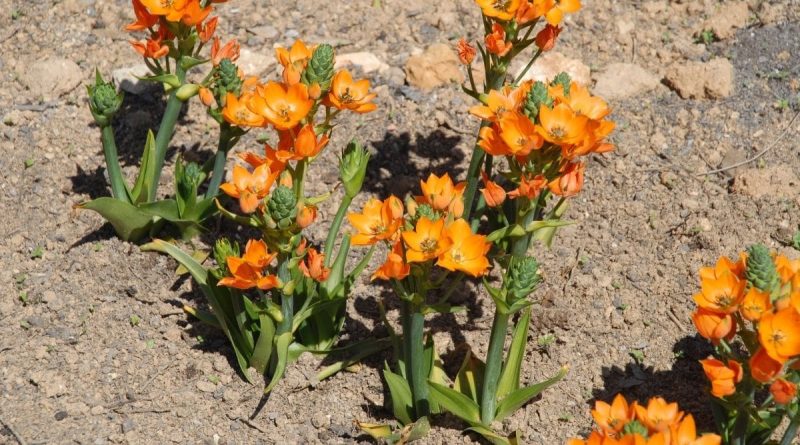
In terms of humidity, Sun Star plants prefer moderate levels around 50-60%. If the air in your home is particularly dry, you can increase humidity levels by using a humidifier or by placing a tray of water near the plant. Avoid placing the plant in an area with high humidity, such as a bathroom, as this can increase the risk of fungal diseases.
Fertilizing the Plant
Sun Star plants are not super heavy feeders, but a bit of fertilizing helps to provide the plant with the necessary nutrients to support healthy growth and blooming.
A balanced, water-soluble fertilizer can work for its basic needs, while a high potassium mix can help to feed the flowers during their blooming cycle. Fertilize the plant every two to three weeks during the growing season, following the instructions on the package for the recommended amount and frequency.
It is important not to over-fertilize the plant, as this can cause damage to the roots and leaves. Always dilute the fertilizer to half-strength or follow the package instructions for the recommended amount.
How to Prune Sun Star Plant
Here are some tips on how to prune your Sun Star plant:
- Remove any dead, damaged, or diseased leaves, flowers or stems as soon as possible to prevent the spread of disease.
- When pruning or deadheading the flowers, take the entire stem down to the base of the plant, but allow the foliage to continue to grow.
Always make sure to use clean, sharp pruning shears to avoid damaging the plant or spreading disease. Additionally, be mindful of the timing and amount of pruning, as excessive pruning can inhibit blooming or lead to stunted growth.
Sun Star Plant Propagation
Sun Star plants can be propagated through seeds or division. The easiest method is by division.
You can dig up the bulbs and cut off the new offsets and plant them in the ground or in pots and keep the soil moist until they are established.
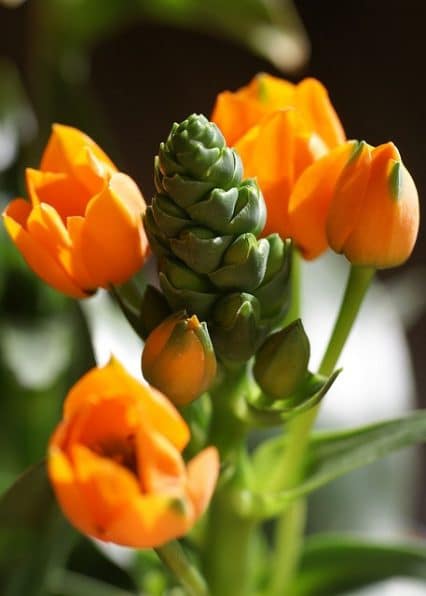
Sun Star Plant Varieties
Ornithogalum dubium, commonly known as Sun Star plant, is a species of the genus Ornithogalum. Several other species of Ornithogalum are closely related to the Sun Star plant, some of which may have similar care requirements and aesthetic qualities. Here are a few examples of other Ornithogalum species:
Ornithogalum Thyrsoides: Also known as the Chincherinchee, this species produces tall spikes of white, star-shaped flowers similar in appearance to the Sun Star plant. It is native to South Africa and prefers well-draining soil and full sun to partial shade.
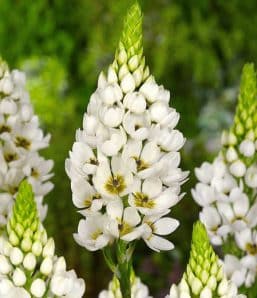
Ornithogalum Saundersiae: This species is native to the Eastern Cape of South Africa and produces clusters of bright white flowers with a dark center. It prefers well-draining soil and full sun to partial shade.
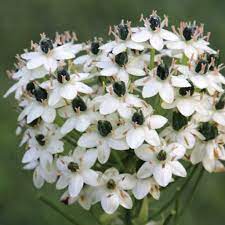
Ornithogalum Arabicum: This species is native to the Mediterranean region and produces tall spikes of white, star-shaped flowers with green stripes. It prefers well-draining soil and full sun to partial shade.
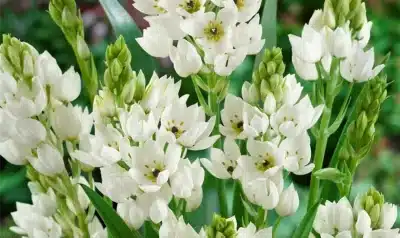
Common Sun Star Plant Problems
While Sun Star plants are relatively easy to care for, they can still fall victim to a few common problems. Here are some of the most common issues you might encounter while caring for your Sun Star plant.
Growing
Some specific growing issues can arise while caring for Sun Star plants. Here are some of the most common problems and how to address them:
- Root rot or bulb rot: Overwatering or poorly draining soil can lead to bulb rot, which can cause your Sun Star plant to wilt, yellow, and eventually die.
- Lack of blooming: While Sun Star plants are known for their vibrant orange flowers, they may not bloom if they are not receiving enough light or nutrients. This can be caused by an inefficient dormancy period, brought on by consistent temperatures.
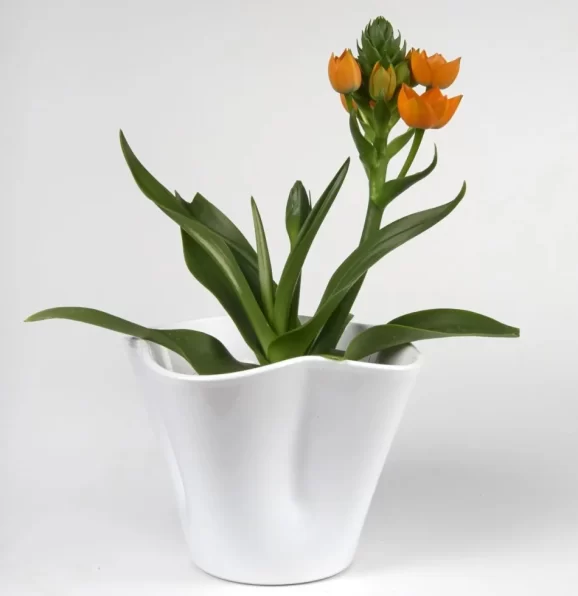
Diseases
While Sun Star plants are relatively resistant to diseases, there are a few fungal and bacterial diseases that can affect them. Generally, most of the issues you will face with this plant are going to be associated with the root system or the bulb. Overwatering can cause bacterial and fungal issues with the Sun Star plant.
Pests
- Mealybugs: Mealybugs are small, white, cottony insects that can be found on the leaves and stems of your Sun Star plant. They suck the sap from the plant, which can cause the leaves to yellow and the plant to become stunted. To get rid of mealybugs, you can use a cotton swab dipped in rubbing alcohol to wipe them off the plant. You can also use an insecticidal soap or neem oil to control them.
- Spider mites: Spider mites are tiny, reddish-brown pests that can be difficult to see with the naked eye. They spin webs on the leaves of your Sun Star plant and suck the sap from the plant, which can cause the leaves to turn yellow and the plant to become stunted. To get rid of spider mites, you can use a strong stream of water to wash them off the plant. You can also use an insecticidal soap or neem oil to control them.
- Scale insects: Scale insects are small, flat, oval-shaped pests that can be found on the leaves and stems of your Sun Star plant. They suck the sap from the plant, which can cause the leaves to yellow and the plant to become stunted. To get rid of scale insects, you can use a cotton swab dipped in rubbing alcohol to wipe them off the plant. You can also use an insecticidal soap or neem oil to control them.
Other Things to Know About the Sun Star Plant
- Flowers: Sun Star plants are prized for their beautiful, star-shaped flowers that can bloom in shades of white, yellow, pink, or red. The flowers can last for several weeks, and the plant can bloom multiple times throughout the year.
- It takes between 2-5 years for the plant to reach its ultimate height.
FAQ’s
Is the Sun Star plant poisonous to cats?
Yes, all parts of the Sun Star plant are considered toxic to cats.
Why are my Sun Star plant leaves turning yellow?
Yellowing leaves on your Sun Star plant can be attributed to several causes. Overwatering, resulting in basal collapse or root rot, and insufficient lighting and fertilization issues.
Can you plant Sun Star outside?
Yes, the Sun Star plant can be planted outdoors where there is sufficient light, temperature and soil conditions.
How is Sun Star plant indoor care different from outdoor?
There is basically no difference in the requirements for growing a Sun Star plant indoors or outdoors. The temperatures and lighting as well as soil conditions, watering and fertilization will remain consistent for both locations.

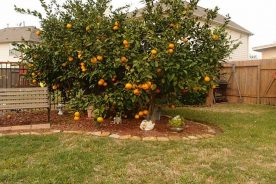
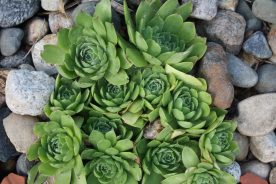
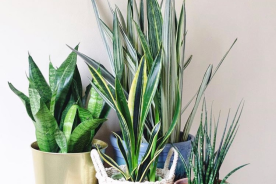

No Comments